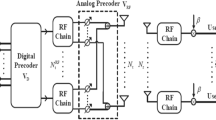Abstract
The upcoming fifth-generation wireless mobile systems are projected to be commercialized in the year 2020 and are set to play the main role in massive multiple input-multiple output (mMIMO) integrated with the technologies of beamforming antenna arrays. However, the performance of mMIMO is constrained by inter-cell interference from adjacent cells triggered by the reused pilot, an issue termed pilot contamination. To address this issue, this paper focuses on mitigating pilot contamination by implementing a suboptimal spatial source detection method based on the beamforming approach using a two-dimension-unitary estimation of the signal parameters through rotational invariance techniques algorithm. We jointly used 2D-AOA information (azimuth and elevation angles) and statistical channel estimations at the BSs to identify the channels correlation condition and evaluate the sum rate performance of users based on AOA. The detected signals from the uniform rectangular array are used to segregate the required signal from the interfering signal without any change to the pilot construction of the training signals. The performance of the minimum mean squared error beamforming (MMSE-beamforming) technique in the multi-cell mMIMO system of the aforementioned method is numerically evaluated and then compared with conventional methods that depend only on pilot identity information. The simulation reveals that the achievable sum rate gains of 2D-AOA and the pilot identity information techniques (best case) with respect to deterministic MMSE are 96.3% and 85.4%, respectively, thus showing the prospect of eliminating the majority of pilot contamination using the 2D-AOA estimation.




Similar content being viewed by others
References
Bjornson, E., Larsson, E. G., & Marzetta, T. L. (2016). Massive MIMO: Ten myths and one critical question. IEEE Communications Magazine, 54(2), 114–123.
Ali, E., Ismail, M., Nordin, R., & Abdulah, N. F. (2017). Beamforming techniques for massive MIMO systems in 5G: overview, classification, and trends for future research. Frontiers of Information Technology & Electronic Engineering, 18(6), 753–772.
Alsharif, M. H., & Nordin, R. (2017). Evolution towards fifth generation (5G) wireless networks: Current trends and challenges in the deployment of millimetre wave, massive MIMO, and small cells. Telecommunication Systems, 64(4), 617–637.
Marzetta, T. L. (2010). Noncooperative cellular wireless with unlimited numbers of base station antennas. IEEE Transactions on Wireless Communications, 9(11), 3590–3600.
Akhlaghpasand, H., & Razavizadeh, S. M. (2017). Adaptive pilot decontamination in multi-cell massive MIMO networks. Telecommunication Systems, 66(3), 515–522.
Fernandes, F., Ashikhmin, A., & Marzetta, T. L. (2013). Inter-cell interference in noncooperative TDD large scale antenna systems. IEEE Journal on Selected Areas in Communications, 31(2), 192–201.
Mazlan, M. H., Behjati, M., Nordin, R., & Ismail, M. (2017). Wiener-based smoother and predictor for massive-MIMO downlink system under pilot contamination. Telecommunication Systems, 67, 1–13.
Lu, L., Li, G. Y., Swindlehurst, A. L., Ashikhmin, A., & Zhang, R. (2014). An overview of massive MIMO: Benefits and challenges. IEEE Journal of Selected Topics in Signal Processing, 8(5), 742–758.
Cottatellucci, L., Muller, R. R., & Vehkapera, M. (2013). Analysis of pilot decontamination based on power control. In 2013 IEEE 77th Vehicular Technology Conference (VTC Spring) (pp. 1–5).
Müller, R. R., Cottatellucci, L., & Vehkaperä, M. (2014). Blind pilot decontamination. IEEE Journal of Selected Topics in Signal Processing, 8(5), 773–786.
Müller, R. R., Vehkaperä, M., & Cottatellucci, L. (2013). Analysis of blind pilot decontamination. In Conf. Rec. - Asilomar Conf. Signals, Syst. Comput., November (pp. 1016–1020).
Appaiah, K., Ashikhmin, A., & Marzetta, T. L. (2010). Pilot contamination reduction in multi-user TDD systems. In 2010 IEEE International Conference on Communications (ICC) (pp. 1–5).
Faisal, A. R., Hashim, F., Noordin, N. K., Ismail, M., & Jamalipour, A. (2016). Efficient beamforming and spectral efficiency maximization in a joint transmission system using an adaptive particle swarm optimization algorithm. Applied Soft Computing, 49, 759–769.
Wang, H., Pan, Z., Ni, J., & Chih-Lin, I. (2013). A spatial domain based method against pilot contamination for multi-cell massive MIMO systems. In Commun. Netw. China (CHINACOM), 2013 8th Int. ICST Conf. (pp. 218–222).
Yin, H., Cottatellucci, L., Gesbert, D., Müller, R. R., & He, G. (2016). Robust pilot decontamination based on joint angle and power domain discrimination. IEEE Transactions on Signal Processing, 64(11), 2990–3003.
Shang, G., & Li, H. (2015) Spatial domain method based on 2D-DoA estimation against pilot contamination for multi-cell massive MIMO systems. In 2015 International Conference on Wireless Communications & Signal Processing (WCSP) (pp. 1–5).
Wang, A., Liu, L., & Zhang, J. (2012). Low complexity direction of arrival (DoA) estimation for 2D massive MIMO systems. In Globecom workshops (GC Wkshps), 2012 IEEE (pp. 703–707).
Wang, T., Ai, B., He, R., & Zhong, Z. (2015). Two-dimension direction-of-arrival estimation for massive MIMO systems. IEEE Access, 3, 2122–2128.
Kuang, J., Zhou, Y., & Fei, Z. (2017). Joint DOA and channel estimation with data detection based on 2D unitary ESPRIT in massive MIMO systems. Frontiers of Information Technology & Electronic Engineering, 18(6), 841–849.
Li, X., Björnson, E., Larsson, E. G., Zhou, S., & Wang, J. (2017). Massive MIMO with multi-cell MMSE processing: Exploiting all pilots for interference suppression. EURASIP Journal on Wireless Communications and Networking, 2017(1), 117.
Kobayashi, R. T., & Abrão, T. (2016). Ordered MMSE–SIC via sorted QR decomposition in ill conditioned large-scale MIMO channels. Telecommunication Systems, 63(2), 335–346.
Li, X., Bjornson, E., Larsson, E. G., Zhou, S., & Wang, J. (2015) A multi-cell mmse precoder for massive MIMO systems and new large system analysis. In Global Communications Conference (GLOBECOM), 2015 IEEE (pp. 1–6).
Ngo, H. Q., Marzetta, T. L., & Larsson, E. G. (2011). Analysis of the pilot contamination effect in very large multicell multiuser MIMO systems for physical channel models. In 2011 IEEE international conference on acoustics, speech and signal processing (ICASSP) (pp. 3464–3467).
Vieira, J., et al. (2014) A flexible 100-antenna testbed for massive MIMO. In Globecom workshops (GC Wkshps), 2014 (pp. 287–293).
Author information
Authors and Affiliations
Corresponding author
Rights and permissions
About this article
Cite this article
Ali, E., Ismail, M., Nordin, R. et al. Beamforming with 2D-AOA estimation for pilot contamination reduction in massive MIMO. Telecommun Syst 71, 541–552 (2019). https://doi.org/10.1007/s11235-018-0529-y
Published:
Issue Date:
DOI: https://doi.org/10.1007/s11235-018-0529-y




